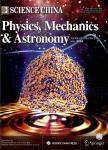Lunar absolute reflectance as observed by Chang'E-1 Imaging Interferometer
Lunar absolute reflectance as observed by Chang'E-1 Imaging Interferometer作者机构:School of Physics Shandong University Institute of Space Sciences Shandong University Shandong Provincial Key Laboratory of Optical Astronomy and Solar-Terrestrial Environment School of Space ScienceShandong University Institute of Geochemistry Chinese Academy of Sciences
出 版 物:《Science China(Physics,Mechanics & Astronomy)》 (中国科学:物理学、力学、天文学(英文版))
年 卷 期:2015年第58卷第8期
页 面:102-107页
核心收录:
学科分类:07[理学] 08[工学] 09[农学] 070401[理学-天体物理] 083002[工学-环境工程] 0830[工学-环境科学与工程(可授工学、理学、农学学位)] 0804[工学-仪器科学与技术] 0903[农学-农业资源与环境] 0805[工学-材料科学与工程(可授工学、理学学位)] 0816[工学-测绘科学与技术] 081602[工学-摄影测量与遥感] 0704[理学-天文学] 081102[工学-检测技术与自动化装置] 0811[工学-控制科学与工程]
基 金:supported by the National Natural Science Foundation of China(Grant Nos.11003012 41373068 41473065 and U1231103)
主 题:Chang'E-1 Imaging Interferometer (IIM) absolute reflectance solar irradiance
摘 要:Lunar absolute reflectance, which describes the fraction of solar radiation reflected by the Moon, is fundamental for the Chang E-1 Imaging Interferometer(IIM) to map lunar mineralogical and elemental distributions. Recent observations made by the Spectral Irradiance Monitor(SIM) onboard the Solar Radiation and Climate Experiment(SORCE) spacecraft indicate that temporal variation in the solar radiation might have non-negligible influence on reflectance calculation, and the SIM measurements are different from the two previously used solar irradiances, i.e., ATLAS3 and Newkur. To provide reliable science results, we examined solar irradiance variability with the SIM daily observations, derived lunar absolute reflectances from the IIM 2A radiance with the SIM, ATLAS3 and Newkur data, and compared them with the Chandrayaan-1 Moon Mineralogy Mapper(M3), the Robotic Lunar Observatory(ROLO) and the Kaguya Multispectral Imager(MI) results. The temporal variability of the SIM solar irradiance is 0.25%–1.1% in the IIM spectral range, and less than 0.2% during the IIM observations. Nevertheless, the differences between the SIM measurements and the ATLAS3 and Newkur data can respectively rise up to 8% and 5% at particular IIM bands, resulting in discrepancy between which might affect compositional mapping. The IIM absolute reflectance we derived for the Moon using the SIM data, except for the last two bands, is consistent with the ROLO and the MI observations, although it is lower.



